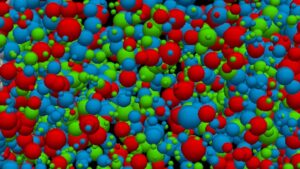
In the minuscule spaces smaller than a wavelength of light, where electric currents leap unpredictably and magnetic fields twist through atomic lattices, a new frontier of observation has been unlocked. Princeton researchers have developed a diamond-based quantum sensor, revealing intricate details of magnetic phenomena previously beyond the reach of existing instruments. This groundbreaking technique offers new insights into materials like graphene and superconductors, which are pivotal in advanced technologies such as medical imaging and potential innovations like lossless powerlines and levitating trains.
The announcement comes as the culmination of half a decade of research into diamond-based sensing methods. In a paper published on November 27 in Nature, the team reported achieving sensitivity roughly 40 times greater than prior techniques. Nathalie de Leon, associate professor of electrical and computer engineering and the study’s senior author, highlighted the unprecedented ability to observe “very small magnetic fields and very small length scales,” thus unveiling magnetic fluctuations that conventional methods could only infer statistically.
Revolutionizing the Study of Quantum Materials
The new technique hinges on engineered defects near the surface of lab-grown diamonds. These diamonds, purer than their natural counterparts, contain minute defects—one missing atom in a lattice of billions—that interact strongly with magnetic fields, making them exceptional sensors. Traditionally, these sensors are treated as isolated points in space. However, de Leon’s team innovatively implanted two defects in close proximity, allowing quantum-mechanical interactions that enhance the system’s capability.
Philip Kim, an experimental physicist at Harvard not involved in the study, remarked on the significance of this development. “This is a very new way of operating this quantum sensor, allowing us to probe real materials directly,” he said. Kim, who studies condensed matter physics, is now collaborating with de Leon using complementary techniques to explore superconductors and graphene, materials with transformative potential yet challenging to engineer at scale.
Harnessing Quantum Entanglement
The creation of this advanced sensor involved firing nitrogen molecules at high speeds into the diamond’s surface, embedding nitrogen atoms deep within its structure. This precise control over the atoms’ placement facilitates quantum entanglement, a phenomenon where the measurement of one atom instantaneously influences the other, despite their separation. This entanglement allows the sensors to effectively filter out noise and pinpoint the source of magnetic fluctuations.
De Leon explained the importance of this scale of measurement, “At this size range, between the atomic scale and the wavelength of visible light, scientists can measure previously invisible quantities, such as the travel distance of electrons or the evolution of magnetic vortices in superconducting materials.”
From Theoretical Curiosity to Practical Application
The breakthrough was initiated by Jared Rovny, a Princeton Quantum Initiative postdoctoral fellow, during the COVID-19 pandemic. With limited lab access, Rovny and de Leon explored theoretical aspects of magnetic noise, leading to the realization of the potential of nitrogen vacancy centers in detecting correlations in magnetic noise.
“It started as one of these weird, Covid, theory projects,” de Leon recalled. The project, initially driven by curiosity, revealed its power as they formalized their findings. Rovny, who now works at the quantum computing startup Logiqal, emphasized the role of his background in nuclear magnetic resonance in shaping the project’s trajectory.
Collaborating with Shimon Kolkowitz, an atomic physicist, Rovny explored non-entangled correlations, resulting in a 2022 Science paper. Yet, it was the entanglement of nitrogen vacancy centers that simplified the process and enhanced sensor effectiveness. “Now all I have to do is a single measurement,” de Leon noted, highlighting the efficiency of the new method.
The paper, “Multi-qubit nanoscale sensing with entanglement as a resource” (DOI 10.1038/s41586-025-09760-y), was published in Nature on November 26, 2025. The research was supported by the Gordon and Betty Moore Foundation, the National Science Foundation, and the Oak Ridge Institute for Science and Education through an interagency agreement between the U.S. Department of Energy and the Office of the Director of National Intelligence.







